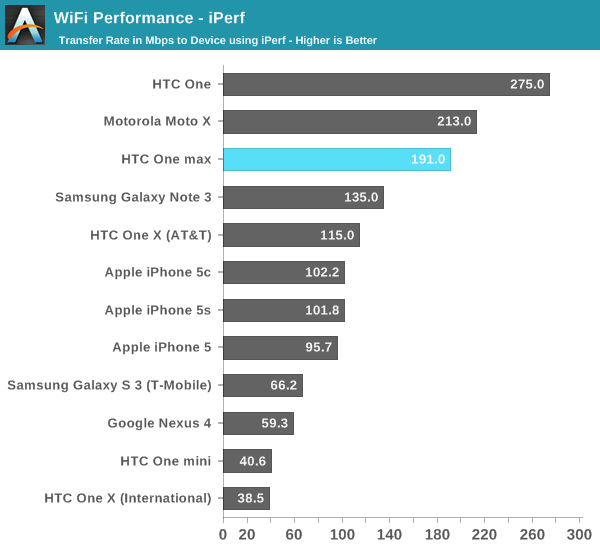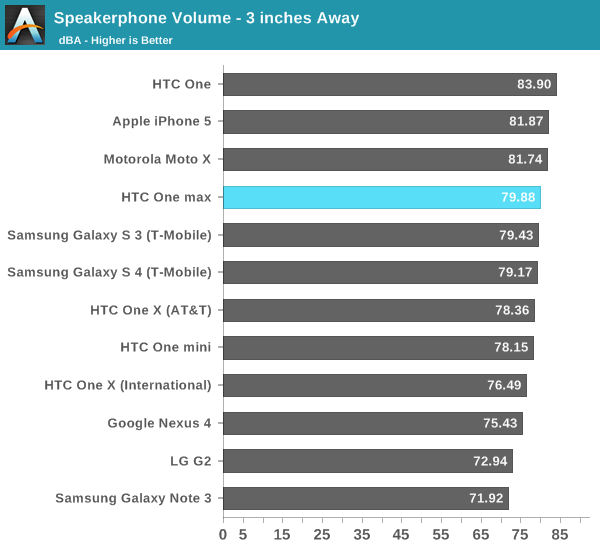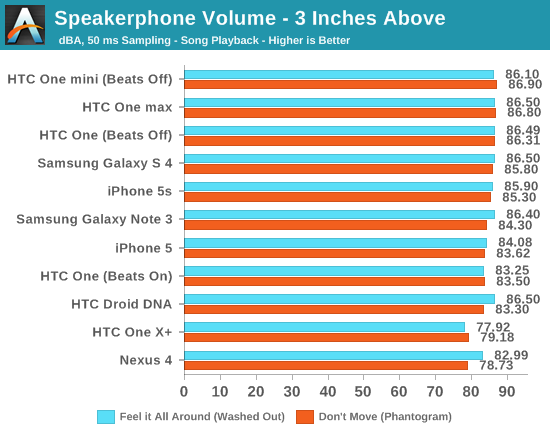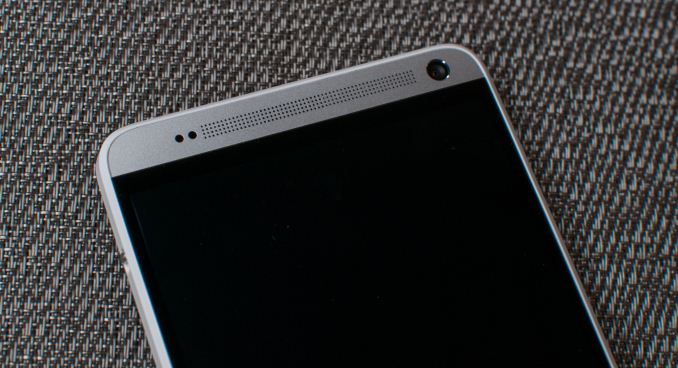HTC One max Review - It's Huge
by Brian Klug on October 28, 2013 10:00 AM EST- Posted in
- Smartphones
- HTC
- Mobile
- One
- Snapdragon 600
- Android 4.3
- One max
Cellular
Cellular on the One max is pretty much the same story as the One, and another shared bullet point. The top and bottom metal cutouts are still the radiative surfaces of the antenna, and there’s still transmit and receive diversity as well to mitigate any unwarranted antenna detuning from holding the device. The unit I was sampled has LTE banding for EMEA (Europe, Middle East, and Africa), but there’s appropriate banding for Asia, Sprint (a tri-mode device with 800/1900 MHz and TDD-LTE on 2600 MHz) and Verizon (700 MHz and AWS), according to the HTC specs page.
The baseband inside the One max is again shared with the One (Qualcomm’s 2nd generation multimode LTE MDM9x15 family), although the One max does have a bit more band support for the USA LTE on Sprint and Verizon, so the front ends are different.
WiFi
Interestingly enough with the One max we see HTC going to Qualcomm Atheros for the WLAN and BT combo, best I can tell this is the WCN3680 which is probably a bit cheaper to include than the BCM4335 we saw in the One. It’s still a single spatial stream 802.11ac capable part, meaning a PHY rate of up to 433 Mbps if you’re in the right channel conditions with 80 MHz channels on 5 GHz. The WCN3680 combo is the 802.11ac successor to WCN3660 which we saw in a number of phones last generation, and is accelerated by the SoC. WCN3680 also does BT 4.0, and FM Rx/Tx if applicable.

To test throughput on the One max I used iPerf the same way I have for a while now. Subjectively there are no complaints from me about WLAN connectivity on the One max, no random dropouts or issues, and Sense 5.5 thankfully still includes the WiFi frequency band manual selection option.
I saw the WCN3680 solution inside Moto X already, it’s interesting to see it in the One max. I believe the One mini uses its 802.11n cousin, WCN3660 as well, probably again for cost reasons.
Speakerphone
Although Beats is gone since that partnership has ended as of the One max, the device still seems to retain everything that made it sound great. There are still the larger-than-typical speaker chambers, big speaker grilles on the top and bottom, stereo sound, and importantly the TFA9887 speaker amplifier and protection part from NXP. In addition there’s still the TPA6185 headphone amplifier as well.
Beats always seemed to be an audio compressor that ran on the DSP, ostensibly through the Hexagon DSP access program or something, and that’s what’s absent on the One max. There’s no toggle under settings for enabling or disabling it, nor the Beats branding, but to be honest I almost always disabled Beats on the One anyways since it was a fair amount louder with it disabled. What made the One great was all the hardware behind the speakers, not so much the software compressor.


The One max goes plenty loud just like the original One. I went ahead and added the One mini and 5s to the chart too, just to check whether things have changed much, in addition to the Galaxy S 4 and Note 3. The One max basically performs like the One with Beats turned off, which isn’t a surprise since it isn’t there anymore. There’s also no detectable saturation, and the One line remains the only device that doesn’t sound tinny or rattly with overemphasized highs and lacking mids. I suspect the A weighting I selected a while ago for measuring might be a contributing factor as well. Either way you’re not going to be wanting for more loudness on the One max, and the inclusion of front firing stereo speakers makes for a completely different listening experience.












197 Comments
View All Comments
ddriver - Monday, October 28, 2013 - link
The note 3 is not really flat, the camera bulges a little bit, but yes, the overall shape of the back cover is flat. It is modular and replaceable though which does open a bit of customization option.kertisoka - Monday, October 28, 2013 - link
I don't think that the camera bulge is a plus though..ddriver - Monday, October 28, 2013 - link
A shame really, they could have put a much better sensor and optics in such a thick body...beginner99 - Monday, October 28, 2013 - link
Well the One and One Mini were already pretty oversized too in comparison to other models with the same screen size so nothing new (and IMHO bad). I like the design but the screen is too small or the chassis too big.FunBunny2 - Monday, October 28, 2013 - link
Ya want stereo speakers on the front? well, until they make speakers that play through the screen, physics will be physics.Omega215D - Tuesday, October 29, 2013 - link
The BoomSound speakers and the different shell thickness/ weight compared to the Samsung. Samsung uses thinner shells in order to achieve their svelt bodies and lighter weight. Also depends on the display technology used. LCDs are heavier than OLEDs.heron_kusanagi - Monday, October 28, 2013 - link
Hi Brian,Could you please do a Nokia Lumia 1020 review?
Drumsticks - Monday, October 28, 2013 - link
I'd also love to see a modern windows phone review. The 1520, personally. I mean, we got a Z10 review didn't we?If nothing else, id love to see a dive into Nokia's imaging on the 1020 and 1520, which is some engineering that I think everyone should be capable of appreciating, no matter how much you dislike the OS.
Alexvrb - Monday, October 28, 2013 - link
Yeah, I'd also like to see a proper 1520 review. I'm not surprised nobody at Anandtech got an invite to Nokia's event. Keep tossing their review phones in a closet (trash can?)... I'd quit sending you anything, if it was up to me. Waste of time and money.On the other hand, since he hates WP, it might just end up being a big ol' take a dump on the WP device article.
kyuu - Monday, October 28, 2013 - link
+1